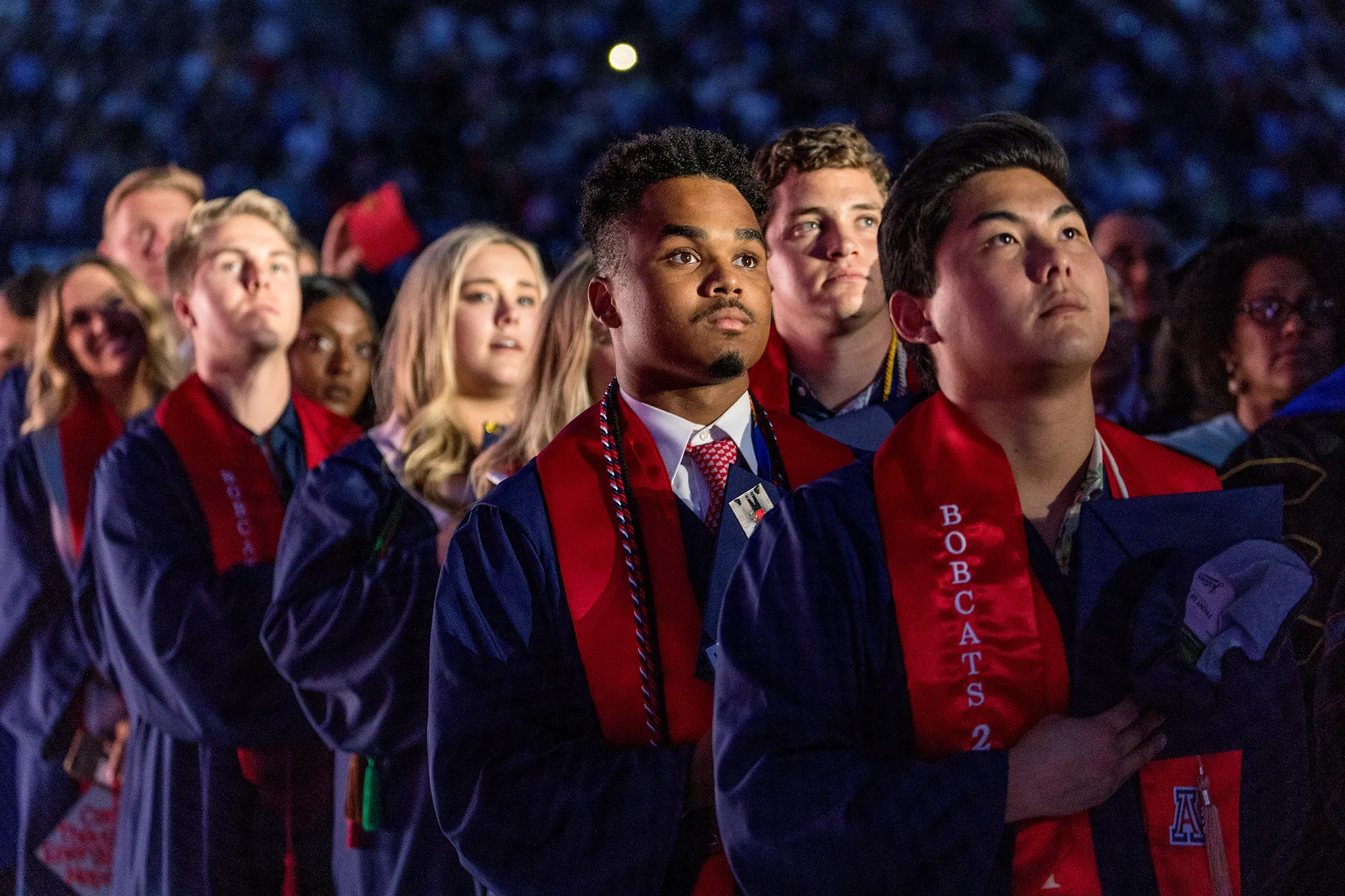Meeting the Moment
UArizona programs constantly evolve to fulfill student and workplace needs.

Graduating members of the Bobcats Senior Honorary sit among peers during commencement exercises at the University of Arizona, where new professional-degree programs aim to mold a student body ready for the workforce.
/ Chris Richards photo
Highly ranked universities like the University of Arizona must move in tandem with the world around them, reflecting changes in culture, in the law, in business and more. That requires them to be remarkably nimble as they adapt to the needs of the community beyond campus — the hungry job market, shifting student career goals — and translate those changes into an education that meets the moment.
Consider the James E. Rogers College of Law, where hundreds of students have graduated with a ground-breaking bachelor of arts in law degree, first offered in 2014, that prepares them to work in fields from government regulation to human resources. Or Health Sciences, which soon will offer degrees for physician assistants, physical therapists and nurse midwives, with the goal of training medical professionals for underserved communities.
Across campus, the College of Architecture, Planning and Landscape Architecture is not only partnering with the department of civil engineering and engineering mechanics to create a discipline-spanning degree but is also offering innovative, hands-on design-build classes and opportunities for students to spend spring break on real jobs with professional companies.
These changes are driven by a combination of data and sophisticated market-watching.
“In all of the states and at the federal level, there is a regular flow of workforce projections in different disciplines and with different levels of training — high school graduates, undergrads, master’s degrees and Ph.D.s or equivalent degrees,” says Provost Liesl Folks, UArizona’s senior vice president for academic affairs.
“We track all of it pretty closely to make sure we’re offering degrees that line up with the highest needs for the state of Arizona — and also for the nation, because we recognize that many of our students travel to meet their career objectives.”
And the changes aren’t only among employers: Employees’ goals and expectations are changing, too. The Association of Public and Land-grant Universities reports that only 58% of workers are expected to return to the jobs they held before the coronavirus pandemic following what’s become known as the “Great Resignation.” But a job search can highlight gaps in an applicant’s education, skills or credentials, and those gaps can be substantial; according to the World Economic Forum, some 54% of workers will need “re-skilling” or “up-skilling” in the coming years.
The upshot is that “labor markets are quite tight, which means that employers are really struggling to find workers,” says George Hammond, director of the Economic and Business Research Center in the UArizona Eller College of Management. “We’re also seeing a continuation of long-term trends toward increased automation. That doesn’t mean workers are necessarily being replaced by machines, but it does mean that we’re all going to be working with technology a lot more in the future than we had been in the past.”
This adds up to big challenges and big opportunities for UArizona, he says. “These kinds of larger technological trends mean we’re going to be seeing increased demand for advanced digital skills, entrepreneurship skills and leadership skills. We’re also seeing increased emphasis on creativity and complex problem-solving — the skills that higher education delivers to students.”
There’s a campuswide campaign to fulfill that mission, says Folks. “We’re always going back and looking at our curriculum to make sure we’re shaping it in those directions. The strong focus now is on things like digital literacy, data science, artificial intelligence, machine learning — technical areas of interest that cut across disciplines.”
“Data science and machine learning lead to interesting opportunities that are between traditional disciplines,” she continues. “There’s a huge amount of interest in health care informatics, for example — how can we literally use machine learning to dig into health care data about individuals and about populations? That would give us information about the services we need to provide to that individual or to a community. That’s one example of bridging a gap between traditional computer science, computer engineering and machine learning to help us provide operational efficiency in the health care sector.”
Another challenge is the growing expectation that new graduates hit the ground running, or being what Folks describes as “workplace ready.” “I think historically, companies were much more tolerant of giving students time to figure out how a professional workplace functions and what their role in it would be,” she says. But today, “there’s a lot of pressure to make sure that students are able to enter the workplace [and] quickly become productive within that workplace.”
What do those productive skills look like? “It means that they have excellent communication skills, that they understand the structure of the workplace — including their likely roles and responsibilities — and that they have an understanding of digital tools that they will be expected to use in the workplace.”
And on top of all the changes in the workplace, university campuses are seeing rapidly shifting student demographics. According to a recent report by the Association of Public and Land-grant Universities, college students now tend to be lower income and older than in the past, and they are more likely to be working in addition to attending college. In addition, 20% of them have children or childcare responsibilities.
In short, today’s student and workforce demands are enormous and rapidly changing. Read on for examples of how they’re being met head-on at UArizona.

/ Adobe Stock image
Health Sciences
This year, the Arizona Board of Regents approved three new degree programs in UArizona Health Sciences — physical therapy, physician assistant and nurse midwifery — with an eye to expanding medical care in Arizona’s underserved rural and urban communities. Opportunities to add additional programs are being explored, according to Michael Dake, senior vice president for UArizona Health Sciences Dake calls the pandemic a major driver of this expansion, saying that it “put a fine edge on the fact that there are significant health care shortages, including in nursing and primary care.”
Another part of the solution is the UArizona College of Medicine – Tucson’s bachelor of science in medicine degree. The four-year program — among only a few of its kind in the country —combines human medical science knowledge and clinical reasoning skills in four areas: medical technology; basic medical sciences; medicine and society; and integrative and practice-focused medicine. While not a medical degree, Dake says the program “expands the options students have to pursue a career in any health-related profession and prepares students to pursue advanced degrees in fields including medicine, nursing or pharmacy.”
Such changes are about not only increasing the number of graduates, Dake says, but also getting graduates into the field sooner, providing care and building healthier communities for all. “We are strategically picking programs that we know will have the most impact.”

/ Adobe Stock image
The James E. Rogers College of Law
The James E. Rogers College of Law offers a first-of-its-kind bachelor of arts in law program, created as a response to changes in the legal profession wrought by globalization, technology and an ever-evolving workforce. For the profession, these shifts mean that work once considered the sole domain of lawyers — from corporate compliance and legal technology consulting to human resources and business management — is increasingly being performed by people who don’t have a law degree but are nonetheless trained legal specialists.
Today, more than 1,500 students are enrolled in the program, says College of Law Dean Marc L. Miller. “Student demand has been huge, because they understand that this opens up a pathway to employment. It’s quite explicitly preparing people for the workforce, not as licensed attorneys, but able to work in legal and regulated settings.”
Like most great ideas, this one didn’t occur in a vacuum, but instead arose from conferring with business leaders about their needs, Miller says. “When we talked to managing partners of firms, or in-house general counsel, or lawyers working on legislative committees or at nonprofits, we often found they had many more employees who were not trained as lawyers or paralegals [than] those who were. And when we asked about the background of those employees, the employer would laugh and say, ‘English? Math? Music?’ They didn’t know.”
Since non-lawyers were already filling those roles, why not replace them with graduates who were actually trained in a legal specialty — and would still cost far less than a lawyer to employ? “Why pay for the full and advanced training when what you really need is an expert to help you work through something?” Miller says.
“Lawyers are trained as generalists. But you might need someone to help you in a family law setting, or with immigration, or specific real estate transactions where you need a person who understands that area and can help.”

As undergraduates forge meaningful bonds at the university, they also explore new majors like the Bachelor of Science in Medicine, the Bachelor of Arts in Law and the Bachelor of Arts in Design Arts and Practices while honing skills coveted by employers.
/ 160/90 photo
The College of Architecture, Planning and Landscape Architecture
The built world evolves around us just as the needs and expectations of the workplace do. CAPLA is constantly innovating its curriculum, with programs that include a combined architecture/engineering bachelor’s degree and a design-build program that deepens the student experience through hands-on projects. Among those projects is a series of row houses that were designed and built by undergraduate architecture students just south of campus. One of those row houses has become a residence for volunteer student emergency techs with University of Arizona Emergency Medical Services.
“I think it’s particularly important for architecture students to have that real, applied experience,” says CAPLA Dean Nancy Pollock-Ellwand. “It helps them to go into the workplace with confidence, skills and knowledge. It also ignites that passion for why they’re in architecture school in the first place.”
Another new program involves externships, where students during spring break travel to built environment firms across the country.
“They go to a firm for a week, shadow an employee in that firm, learn about life as a working professional and make connections,” says Pollock-Ellwand. “The students get that exciting taste of an intense experience in the workplace. They are establishing relationships and they are learning about the breadth and scope of their field. It’s been a great success, and as we build this out, we’re going to be expanding it to disciplines across the college.”
The externship is among several strategies the college has initiated to make sure its students are ready for professional roles when they leave school. “It’s important to underline that we are known for very good graduates who are ready to walk into the workplace,” Pollock-Ellwand says. “That’s something that we are very conscious of in the education we provide.”
Meanwhile, the college continues to collaborate with other disciplines across campus, from engineering to the humanities. “We’re teaching in the undergraduate applied humanities degree for students who are interested in design thinking,” Pollock-Ellwand says.
“And we launched the Object and Spatial Design emphasis areas within the Bachelor of Arts in Design Arts and Practices with the School of Art and School of Information last fall.”
Pollock-Ellwand calls the degrees part of a larger trend toward interdisciplinary collaboration, a reality in the workplace. “It’s really the way we have to address contemporary complex issues,” she says. “It is a natural movement that’s occurring, and that’s why I’m pleased to be working as a dean within the University of Arizona, where there is a mindset and commitment to collaborate.”
